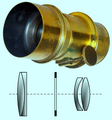Petzval lens
The Petzval lens is the first portrait lens (100 mm focal length ) in photo history ; it was designed by Josef Maximilian Petzval in Austria in 1840 and first built by Voigtländer under Peter Wilhelm Friedrich von Voigtländer , later Carl Dietzler was added as a producer.
innovation
The lens established two innovations: On the one hand, with a largest aperture of 1: 3.6, it was considerably brighter than previous lenses , which, under favorable conditions, made portraits with exposure times of less than a minute possible for the first time .
On the other hand, Petzval calculated the composition of the lenses for the first time on the basis of optical laws, while opticians had previously ground lenses based on empirical values. Archduke Ludwig of Austria (Commander-in-Chief of the Artillery ) provided him with 8 artillery gunners and 3 corporals for the calculations , since artillery was one of the few professions in which mathematical calculations were made at the time.
history
The Petzval lens was produced by Voigtländer and sold worldwide, until 1862 it produced 60,000 pieces.
Among the disadvantages of Petzval's design included a strong focus drop at the edges, in that of Hugo Adolph Steinheil developed Aplanat was corrected out.
A crowdfunding project started on Kickstarter.com recreated the lens in order to be able to use it on current cameras.
Picture gallery
Other scientists who worked for Voigtländer
Web links
- Sporn, Christian: Historical methods in photography: The Petzval lens (departmental thesis in physics 1998/1999 at the Kollegium Aloisianum , Linz; PDF; 43 kB).
- All-metal camera No. 84 from 1840 with a Petzval lens , collection of the Deutsches Museum
Individual evidence
- ↑ The Lomography Petzval Portrait Lens on Kickstarter, accessed July 29, 2013
- ↑ Andreas Donath: 170 year old lens for digital cameras on golem.de from July 29, 2013, accessed on July 29, 2013
- ↑ Andreas Donath: 170 year old lens for digital cameras can be ordered. golem.de , December 16, 2013, accessed December 16, 2013 .


